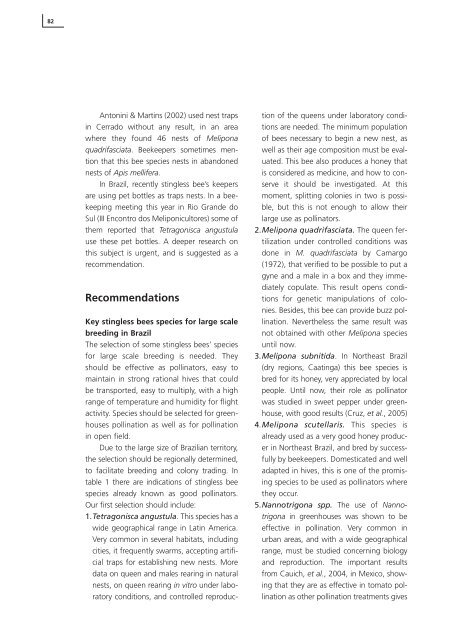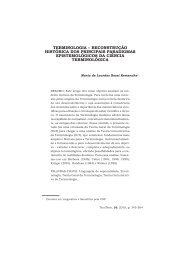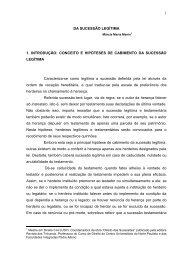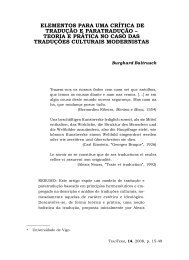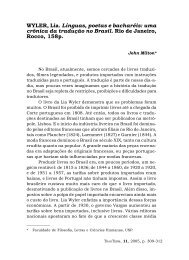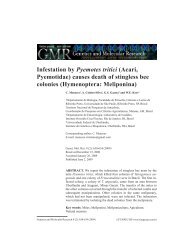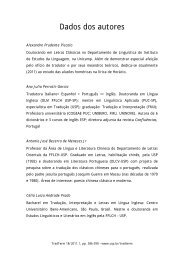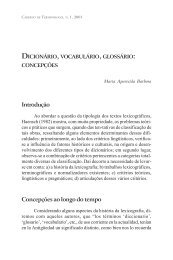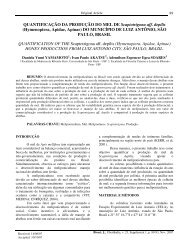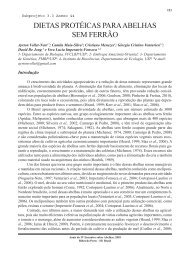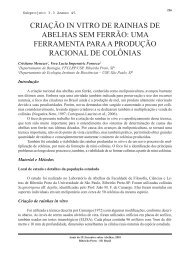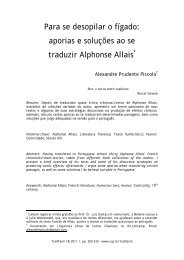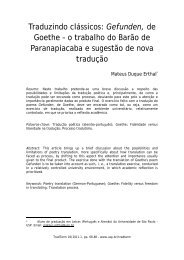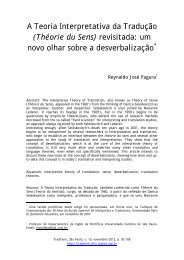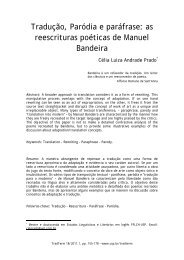Bees as pollinators in Brazil - USP
Bees as pollinators in Brazil - USP
Bees as pollinators in Brazil - USP
You also want an ePaper? Increase the reach of your titles
YUMPU automatically turns print PDFs into web optimized ePapers that Google loves.
82<br />
Anton<strong>in</strong>i & Mart<strong>in</strong>s (2002) used nest traps<br />
<strong>in</strong> Cerrado without any result, <strong>in</strong> an area<br />
where they found 46 nests of Melipona<br />
quadrif<strong>as</strong>ciata. Beekeepers sometimes mention<br />
that this bee species nests <strong>in</strong> abandoned<br />
nests of Apis mellifera.<br />
In <strong>Brazil</strong>, recently st<strong>in</strong>gless bee’s keepers<br />
are us<strong>in</strong>g pet bottles <strong>as</strong> traps nests. In a beekeep<strong>in</strong>g<br />
meet<strong>in</strong>g this year <strong>in</strong> Rio Grande do<br />
Sul (III Encontro dos Meliponicultores) some of<br />
them reported that Tetragonisca angustula<br />
use these pet bottles. A deeper research on<br />
this subject is urgent, and is suggested <strong>as</strong> a<br />
recommendation.<br />
Recommendations<br />
Key st<strong>in</strong>gless bees species for large scale<br />
breed<strong>in</strong>g <strong>in</strong> <strong>Brazil</strong><br />
The selection of some st<strong>in</strong>gless bees’ species<br />
for large scale breed<strong>in</strong>g is needed. They<br />
should be effective <strong>as</strong> <strong>poll<strong>in</strong>ators</strong>, e<strong>as</strong>y to<br />
ma<strong>in</strong>ta<strong>in</strong> <strong>in</strong> strong rational hives that could<br />
be transported, e<strong>as</strong>y to multiply, with a high<br />
range of temperature and humidity for flight<br />
activity. Species should be selected for greenhouses<br />
poll<strong>in</strong>ation <strong>as</strong> well <strong>as</strong> for poll<strong>in</strong>ation<br />
<strong>in</strong> open field.<br />
Due to the large size of <strong>Brazil</strong>ian territory,<br />
the selection should be regionally determ<strong>in</strong>ed,<br />
to facilitate breed<strong>in</strong>g and colony trad<strong>in</strong>g. In<br />
table 1 there are <strong>in</strong>dications of st<strong>in</strong>gless bee<br />
species already known <strong>as</strong> good <strong>poll<strong>in</strong>ators</strong>.<br />
Our first selection should <strong>in</strong>clude:<br />
1.Tetragonisca angustula. This species h<strong>as</strong> a<br />
wide geographical range <strong>in</strong> Lat<strong>in</strong> America.<br />
Very common <strong>in</strong> several habitats, <strong>in</strong>clud<strong>in</strong>g<br />
cities, it frequently swarms, accept<strong>in</strong>g artificial<br />
traps for establish<strong>in</strong>g new nests. More<br />
data on queen and males rear<strong>in</strong>g <strong>in</strong> natural<br />
nests, on queen rear<strong>in</strong>g <strong>in</strong> vitro under laboratory<br />
conditions, and controlled reproduc-<br />
tion of the queens under laboratory conditions<br />
are needed. The m<strong>in</strong>imum population<br />
of bees necessary to beg<strong>in</strong> a new nest, <strong>as</strong><br />
well <strong>as</strong> their age composition must be evaluated.<br />
This bee also produces a honey that<br />
is considered <strong>as</strong> medic<strong>in</strong>e, and how to conserve<br />
it should be <strong>in</strong>vestigated. At this<br />
moment, splitt<strong>in</strong>g colonies <strong>in</strong> two is possible,<br />
but this is not enough to allow their<br />
large use <strong>as</strong> <strong>poll<strong>in</strong>ators</strong>.<br />
2.Melipona quadrif<strong>as</strong>ciata. The queen fertilization<br />
under controlled conditions w<strong>as</strong><br />
done <strong>in</strong> M. quadrif<strong>as</strong>ciata by Camargo<br />
(1972), that verified to be possible to put a<br />
gyne and a male <strong>in</strong> a box and they immediately<br />
copulate. This result opens conditions<br />
for genetic manipulations of colo -<br />
nies. Besides, this bee can provide buzz poll<strong>in</strong>ation.<br />
Nevertheless the same result w<strong>as</strong><br />
not obta<strong>in</strong>ed with other Melipona species<br />
until now.<br />
3.Melipona subnitida. In Northe<strong>as</strong>t <strong>Brazil</strong><br />
(dry regions, Caat<strong>in</strong>ga) this bee species is<br />
bred for its honey, very appreciated by local<br />
people. Until now, their role <strong>as</strong> poll<strong>in</strong>ator<br />
w<strong>as</strong> studied <strong>in</strong> sweet pepper under greenhouse,<br />
with good results (Cruz, et al., 2005)<br />
4.Melipona scutellaris. This species is<br />
already used <strong>as</strong> a very good honey producer<br />
<strong>in</strong> Northe<strong>as</strong>t <strong>Brazil</strong>, and bred by successfully<br />
by beekeepers. Domesticated and well<br />
adapted <strong>in</strong> hives, this is one of the promis<strong>in</strong>g<br />
species to be used <strong>as</strong> <strong>poll<strong>in</strong>ators</strong> where<br />
they occur.<br />
5.Nannotrigona spp. The use of Nan no -<br />
trigona <strong>in</strong> greenhouses w<strong>as</strong> shown to be<br />
effective <strong>in</strong> poll<strong>in</strong>ation. Very common <strong>in</strong><br />
urban are<strong>as</strong>, and with a wide geographical<br />
range, must be studied concern<strong>in</strong>g biology<br />
and reproduction. The important results<br />
from Cauich, et al., 2004, <strong>in</strong> Mexico, show<strong>in</strong>g<br />
that they are <strong>as</strong> effective <strong>in</strong> tomato poll<strong>in</strong>ation<br />
<strong>as</strong> other poll<strong>in</strong>ation treatments gives


